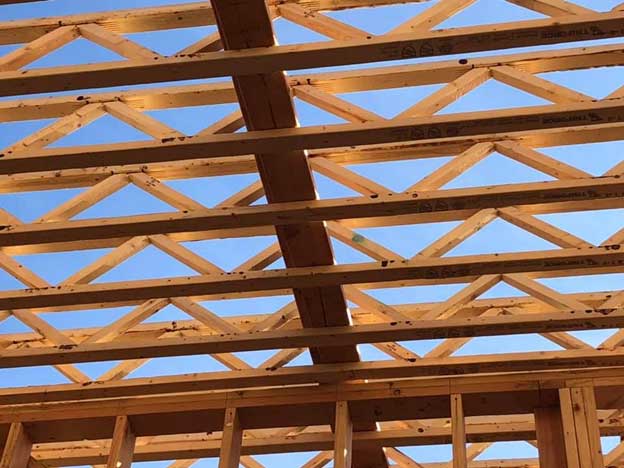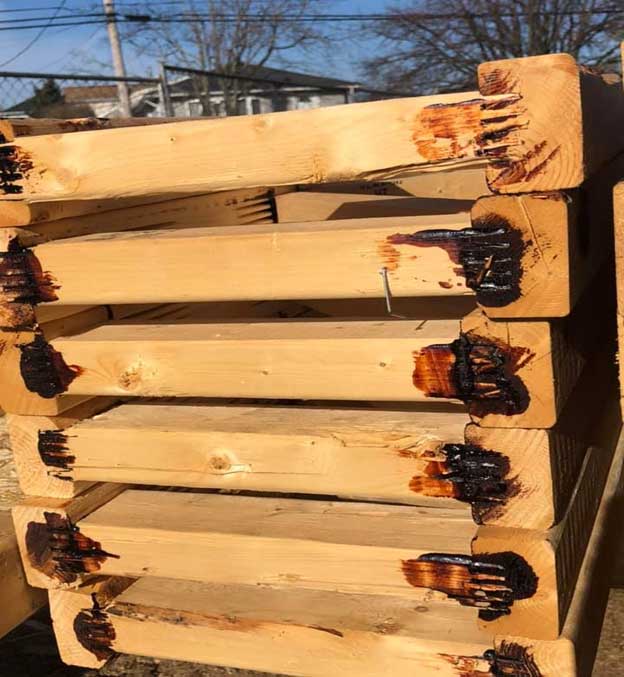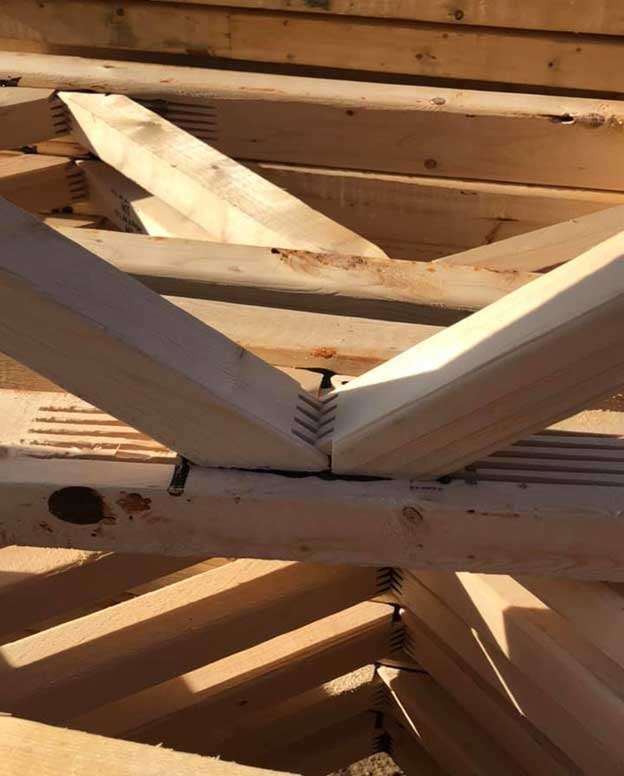
By Salvatore Ancona
All images courtesy of author
So have you seen it? Structural and civil engineers are always working to create the next new product that will revolutionize the construction industry. Finger jointed wood trusses are certainly not new however, in fact they have been around since 1989. Products within the building community come in and out of favor over the years. Whenever a firefighter is discussing parallel chord wood trusses he or she automatically reverts to a wood truss with metal plate connectors or gussets and associates all such structural elements with that product. There are many different products available to consumers as far as engineered wood products (EWP) are concerned so it is important to keep up on what’s trending. Finger jointed wood trusses are an engineered wood product designed for residential/light commercial application (photo 1) and they are making an appearance more and more. Before you get the pitchforks, let’s discuss their construction, application, fire resistance, and concerns.

Finger joints have been around since early Egyptian times. They are used today in an engineering application to join lumber products together to achieve certain lengths while maintaining structural stability. When we see them used as floor or rood joists we automatically think it’s got to be weaker…right? Now I’m no fan of engineered wood products as a whole but there are aspects to some products that can replicate their dimensional wood counterparts. Finger jointed wood trusses are composite in nature, meaning they use two or more different materials to achieve the desired strength or use. The two materials are lumber and adhesive (photo 2).

The top chord and bottom chords are usually 2×3 with the web members comprised of smaller dimensions. The finger joints are precut into the chords and web members (photo 3). They are later seated tightly into the joints and secured via adhesive. Many have indicated that the use of engineered products such as this is due to money savings. This is not accurate. In fact, finger jointed wood trusses can be as much as three times more expensive than their dimensional lumber counterparts. What is evident however is that their usage is primarily based on the homeowner. They provide the homeowner with a stronger product that can achieve the longer span that the homeowner desires. Open floor plans are the in thing now, so plan on seeing these engineered materials more and more.

Of great concern are the adhesives used in engineered materials. Many believe that the adhesives or glues used are flammable, combustible, or that they melt or soften under fire conditions. This may have been true many years ago, but the adhesives used today are much more resilient and sometimes even stronger than the lumber they are supporting. Finger jointed wood trusses use Resorcinol adhesive (resorcinol-formaldehyde). Resorcinol was traditionally used in marine applications because of its water resistance. In lumber applications it has been shown that resorcinol adhesive is stronger under fire conditions than lumber, degrading after temperatures of 1,100° F. Resorcinol adhesive does not delaminate under heat, and does not melt. Based on available literature, the adhesive does not aid in combustion or play a factor in early failure, unlike that of metal plate connectors in parallel chord wood trusses.
Members should be aware that finger jointed wood trusses are still engineered materials that are susceptible to their construction within the factory, transportation, storage and installation. If the adhesive was not properly applied, loads could be inappropriately transferred should the failure of web members occur. Finger jointed wood trusses fail bottom up. The bottom chord fails first, so sagging could be seen as with wood I-beams, but this is not always evident. Fire travel is the big picture here. As with all open web concepts, fire can travel unimpeded within the web members and consume an entire floor system. Web members could have been damaged because of the installation of utilities, which transfers loads disproportionately. Many of the fire resistance testing is third party or private so there is not much information available when it comes to the inherent fire resistance or the structural stability of finger jointed wood trusses when they are attacked by fire. As always, firefighters must be vigilant and monitor conditions when these materials are attacked by fire and address this early on. Whenever it becomes evident that finger jointed wood trusses are being attacked by fire, members should immediately address it. In addition, fires involving unprotected finger jointed wood trusses should be checked early and construction should be monitored.
 SALVATORE ANCONA is a deputy chief fire instructor at the Nassau County (NY) Fire Service Academy; a former captain and training officer for the Bellmore (NY) Fire Department; and a paramedic supervisor in Queens, New York. He has an A.S. degree in fire science from Nassau Community College and is in the emergency services administration undergraduate program at John Jay College of Criminal Justice. Ancona is the author of the building construction page “The Sons of Brannigan” on Facebook and was a recipient of the 2019 FDIC International Honeywell DuPont Scholarship.
SALVATORE ANCONA is a deputy chief fire instructor at the Nassau County (NY) Fire Service Academy; a former captain and training officer for the Bellmore (NY) Fire Department; and a paramedic supervisor in Queens, New York. He has an A.S. degree in fire science from Nassau Community College and is in the emergency services administration undergraduate program at John Jay College of Criminal Justice. Ancona is the author of the building construction page “The Sons of Brannigan” on Facebook and was a recipient of the 2019 FDIC International Honeywell DuPont Scholarship.
MORE
Firefighters and Construction: Changes on Main Street: Modern Taxpayers
Firefighters and Construction: Bowstring/Arched Rib Truss Roof Systems
Podcast: In Their Own Words: Sal Ancona
Best Practices for Tackling Fires in Balloon-Frame Construction

